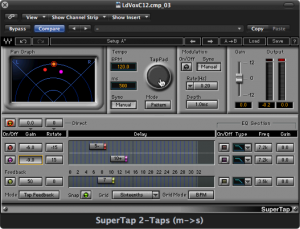One of the most common special effects is using delay to create an echo effect. This is used often in popular music. The challenge with a delay effect is to synchronize the timing of the echoes with the beat of the music. If you’re using a delay plug-in with a DAW program, the plug-in will try to use the metronome of your project file to create the delay timing. This works if you recorded the music to the system’s metronome, but if you just recorded everything freestyle you have to synchronize the delay manually. Typically this is done with a tap pad. Also called tap-delay, this plug-in uses a pad or button that you can tap along with the beat of the music to keep the echoes synchronized. Usually after eight taps, the echoes get in sync with the music, but as the performance from the musician changes, you need to periodically re-tap the plug-in. Figure 7.31 shows a tap delay processor with the mouse pointer on the tap pad.

Other special effects including flangers, pitch shifting/autotune, etc. may be applied in several different situations. There are really no rules with special effects. Just make sure you have a real reason for using the effect and don’t overdo it.